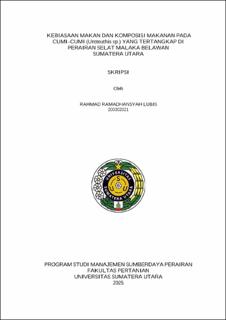Kebiasaan Makan dan Komposisi Makanan pada Cumi-cumi (Uroteuthis sp.) yang Tertangkap di Perairan Selat Malaka Belawan Sumatera Utara
Feeding Habits and Food Composition of Squid (Uroteuthis sp.) Caught in the Waters of the Malacca Strait, Belawan, North Sumatra

Date
2025Author
Lubis, Rahmad Ramadhansyah
Advisor(s)
Manurung, Vindy Rilani
Metadata
Show full item recordAbstract
This research on the feeding habits and food composition of squid (Uroteuthis sp.) caught in the waters of the Malacca Strait, Belawan, North Sumatra, aims to determine the feeding habits and dietary composition of squid (Uroteuthis sp.) caught in these waters. The study was conducted from January to March 2024. The method used was random sampling, with samples collected randomly. The results showed that the total number of squid samples caught was 210, consisting of 109 females and 101 males, with mantle lengths ranging from 85 to 406 mm. The growth pattern of squid (Uroteuthis sp.) was negatively allometric, with the condition factor categorized as slim, ranging from 0.334 to 2.465. The highest stomach fullness index was recorded in January, with females at 1.045% and males at 1.605%. Fish were the most frequently occurring item in the squid’s stomach contents, with the highest food composition index (IP) of 92.314% across all sampling months, followed by shrimp with an IP of 38.055% as a complementary food, phytoplankton with an IP of 8.743%, and zooplankton with an IP of 1.090% as supplementary food. Squid feed at night, and the structure of their stomach tissue consists of the mucosa and submucosa, with the mucosa being the innermost layer in direct contact with food, and the submucosa supplying nutrients and oxygen to the mucosal tissue.
Collections
- Undergraduate Theses [817]
